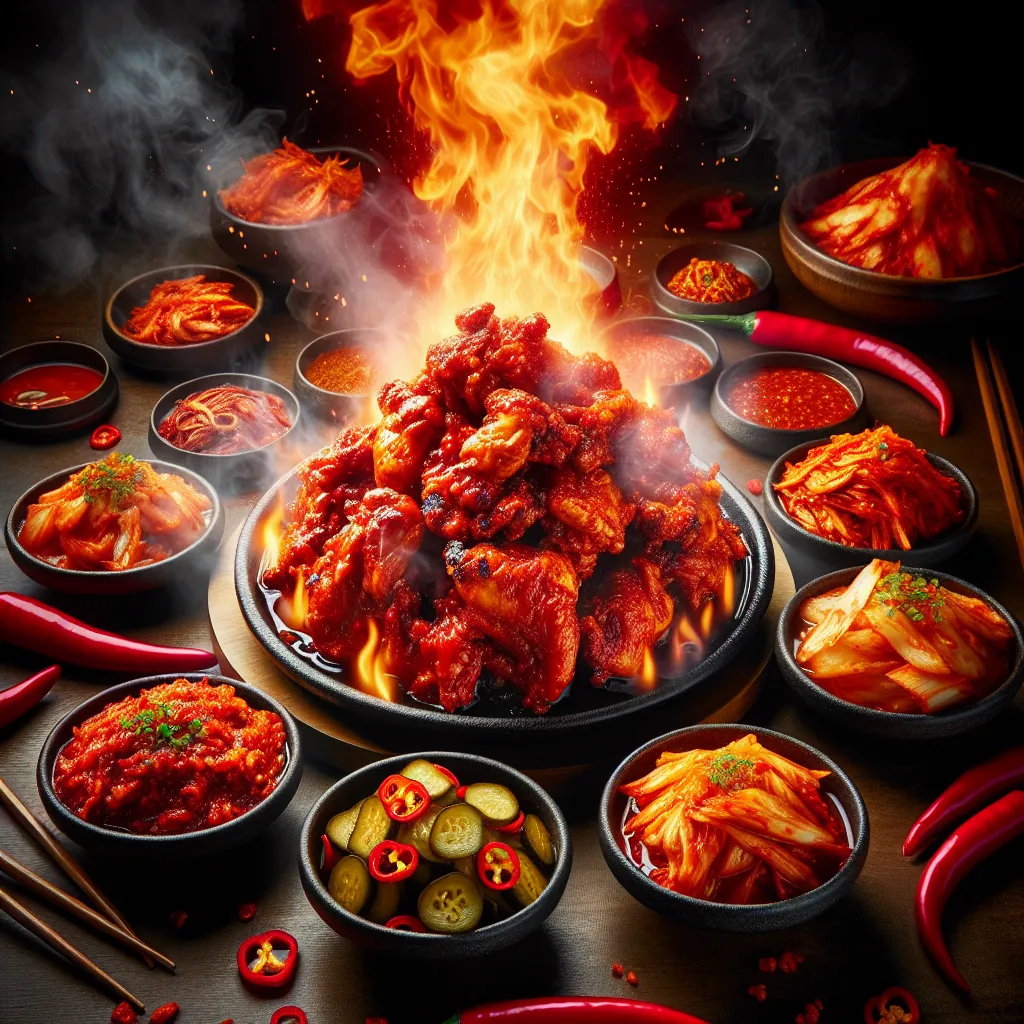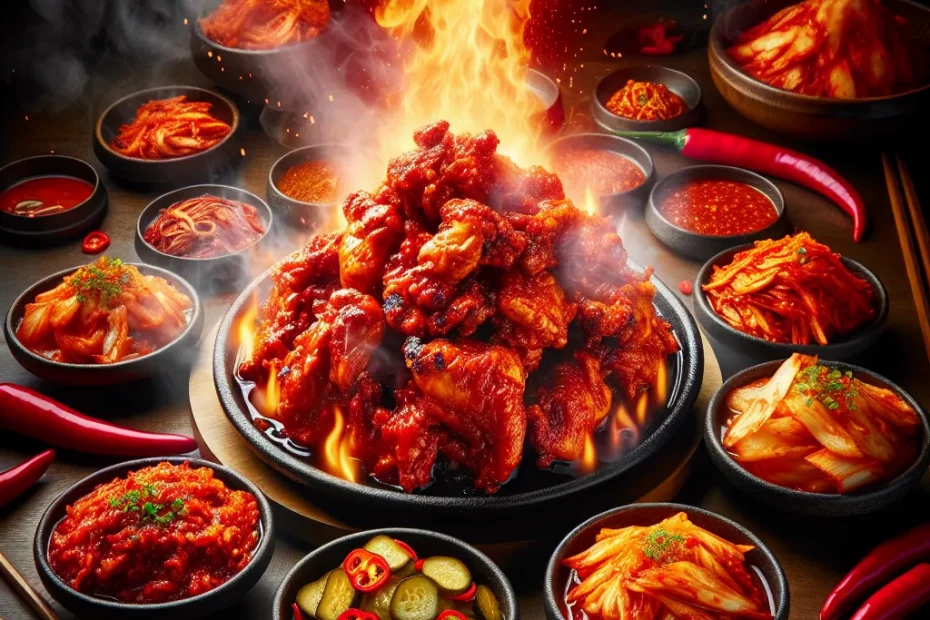Korean cuisine is renowned for its bold flavors and spicy dishes, captivating food enthusiasts around the world. From fiery kimchi to mouth-watering buldak, Korean spicy cuisine offers a unique culinary experience that ignites the taste buds. The use of gochugaru, gochujang, and other traditional spices adds depth and complexity to dishes, making them a favorite among those who crave a kick of heat in their meals. Beyond the delicious taste, spicy Korean food also boasts various health benefits, making it not only a flavorful choice but a nutritious one as well. Explore the rich tapestry of Korean spicy cuisine and discover the love for fiery flavors that captivates food lovers globally.

The Spiciest Dishes in Korean Cuisine
In the realm of Korean cuisine, fiery flavors and bold spices reign supreme, captivating the taste buds of spice enthusiasts around the globe. From tongue-tingling kimchi to sweat-inducing buldak, Korean cuisine offers a wide array of dishes that are not for the faint of heart. Let’s dive into the world of the spiciest dishes that Korea has to offer, where heat meets flavor in a harmonious culinary symphony! 🔥🌶️
Buldak: Fire Chicken
One of the standout spicy dishes in Korean cuisine is “Buldak”, also known as fire chicken. This dish features marinated chicken cooked in a blazing hot sauce made from a potent blend of chili peppers, garlic, and other secret spices. The heat level of buldak is off the charts, leaving diners reaching for a glass of cold water in between each fiery bite! 🔥🍗
Yeolmu Kimchi
If you’re seeking a dish that will set your taste buds on fire, look no further than “Yeolmu Kimchi”. This variation of kimchi is made with young radish greens and a generous amount of red chili pepper flakes, creating a spicy and refreshing side dish that pairs perfectly with a bowl of steaming rice. The crunch of the greens combined with the intense heat of the kimchi is a flavor explosion like no other! 🌶️🥬
Haemul Jjamppong
For those who crave a spicy kick with a touch of seafood, “Haemul Jjamppong” is the perfect choice. This fiery seafood noodle soup is brimming with an assortment of fresh seafood, vegetables, and a spicy broth that will leave your lips tingling with delight. The combination of tender seafood and bold spices makes Haemul Jjamppong a must-try for spice lovers! 🍤🔥
Dakbal: Spicy Chicken Feet
Another iconic spicy dish in Korean cuisine is “Dakbal”, which translates to spicy chicken feet. This dish features tender chicken feet cooked in a fiery sauce that packs a serious punch. The gelatinous texture of the chicken feet combined with the intense heat of the sauce creates a unique dining experience that is not for the faint of heart. Dare to try Dakbal for a true taste of Korean spice! 🌶️🍗
In conclusion, Korean cuisine offers a plethora of spicy dishes that cater to those who seek bold flavors and intense heat. Whether you’re a spice connoisseur or looking to challenge your taste buds, exploring the spiciest dishes in Korean cuisine is a culinary adventure like no other. Prepare yourself for a flavor-packed journey filled with heat, spice, and unforgettable dining experiences! 🌶️🔥
Regional Varieties of Spicy Korean Food
Exploring the diverse and vibrant world of Korean cuisine, one cannot overlook the rich tapestry of spicy flavors that define many traditional dishes. From fiery kimchi to mouth-watering buldak, Korea’s spicy food culture is as varied as it is delicious! Let’s delve into the regional varieties of spicy Korean food that showcase the unique culinary heritage of different areas across the Korean peninsula.
In Seoul
In the bustling streets of Seoul, the capital city, one can find an array of spicy delights that cater to every palate. The iconic Kimchi Jjigae, a spicy stew made with fermented cabbage, is a staple in Korean households and restaurants alike. The spicy kick of the gochugaru (red chili pepper flakes) combined with the tangy kimchi creates a harmonious explosion of flavors that is sure to tantalize your taste buds!
In Busan
Venturing down south to Busan, Korea’s second-largest city, one cannot miss the famous dwaeji gukbap, a spicy pork soup that is beloved by locals and visitors alike. Made with tender pork, hearty vegetables, and a generous amount of red pepper paste, this dish is a comforting and satisfying choice for those craving a spicy fix.
In Incheon
On the western coast of Korea lies Incheon, a city known for its unique take on spicy cuisine. Here, you can indulge in the delectable jjamppong, a spicy seafood noodle soup that packs a flavorful punch. The combination of fresh seafood, spicy broth, and chewy noodles makes this dish a true delight for seafood lovers and spice enthusiasts alike.
In Gangwon
Heading to the eastern province of Gangwon, one can savor the iconic dakgalbi, a spicy stir-fried chicken dish that is a favorite among locals. The tender chicken, crisp vegetables, and fiery gochujang (red chili paste) come together to create a dish that is both comforting and exhilarating.
In Jeju Island
In Jeju Island, Korea’s picturesque island paradise, one can sample the unique and flavorful haemul bokkeumbap, a spicy seafood fried rice that showcases the freshest ingredients the island has to offer. The combination of spicy gochujang, tender seafood, and fragrant rice makes this dish a must-try for those looking to experience the bold flavors of Jeju.
From the bustling streets of Seoul to the tranquil shores of Jeju Island, the regional varieties of spicy Korean food offer a glimpse into the diverse and dynamic culinary landscape of Korea. Whether you prefer the fiery heat of kimchi or the comforting spice of dwaeji gukbap, there is a spicy dish to suit every taste bud in Korea’s vibrant food scene! 🌶🍲🔥
Popular Spices and Seasonings in Korean Cooking
Korean cuisine is renowned for its bold flavors and aromatic spices that tantalize the taste buds. From fiery red pepper flakes to savory soy sauce, Korean cooking is a harmonious blend of diverse seasonings that elevate each dish to a culinary masterpiece. Let’s delve into the world of popular spices and seasonings that are essential in Korean cooking!
Gochugaru (고추가루)
Gochugaru: This vibrant red pepper powder is a staple in Korean cuisine, adding a kick of heat and depth of flavor to various dishes. Gochugaru is commonly used in making kimchi, stews, and marinades, giving that signature spicy taste that Korean food is known for.
Sesame Oil (참기름)
Sesame Oil: Rich and nutty, sesame oil is a key ingredient in Korean cooking, imparting a distinctive aroma and flavor to dishes. It is often drizzled over rice, noodles, and stir-fries, enhancing the overall taste with its earthy notes.
Soy Sauce (간장)
Soy Sauce: A fundamental seasoning in Korean cuisine, soy sauce adds a savory umami taste to a wide range of dishes. Whether used as a marinade, dipping sauce, or seasoning, soy sauce brings depth and complexity to the flavors of Korean food.
Garlic (마늘)
Garlic: Known for its pungent aroma and robust flavor, garlic is a versatile ingredient in Korean cooking. It is often minced or crushed to release its intense taste, used in marinades, stir-fries, and soups to enhance the overall savory profile of the dish.
Ginger (생강)
Ginger: With its warm and spicy undertones, ginger is a popular spice in Korean cuisine, adding a refreshing zing to dishes. Whether grated, sliced, or minced, ginger is used in both savory and sweet dishes, bringing a unique flavor that complements other seasonings.
Honey (꿀)
Honey: In Korean cooking, honey is not only a natural sweetener but also a key ingredient in marinades and sauces. Its subtle sweetness balances out the spiciness and saltiness of other seasonings, creating a harmonious flavor profile in dishes like dak bulgogi (Korean honey chicken).
Perilla Leaves (깻잎)
Perilla Leaves: These aromatic leaves are often used in Korean cuisine as a wrap for grilled meats or as a flavorful addition to salads and side dishes. Perilla leaves have a distinct minty and peppery taste, adding a refreshing herbal note to the overall flavor of the dish.
From the fiery heat of gochugaru to the aromatic richness of sesame oil, Korean cooking is a celebration of diverse spices and seasonings that come together to create unforgettable culinary experiences. Each ingredient plays a vital role in enhancing the flavors and textures of Korean dishes, showcasing the depth and complexity of this beloved cuisine. Embrace the vibrant world of Korean spices and seasonings, and embark on a flavorful journey that will delight your senses!
🍲🇰🇷
Health Benefits of Spicy Korean Cuisine
Indulging in the fiery flavors of Korean cuisine not only tantalizes the taste buds but also offers a plethora of health benefits. From kimchi to gochujang, the spicy elements in Korean dishes are packed with nutrients that can boost your overall well-being. 🌶️🍲
The Power of Gochujang
One of the key components of Korean spicy cuisine is gochujang, a fermented chili paste that is rich in capsaicin. Capsaicin is known for its anti-inflammatory properties and can help alleviate pain and reduce the risk of chronic diseases. Studies have shown that capsaicin may even aid in weight loss by increasing metabolism and reducing appetite. 🔥💊
The Benefits of Kimchi
Another staple in Korean cuisine is kimchi, a spicy fermented vegetable dish. Kimchi is loaded with probiotics, which are beneficial for gut health. The probiotics in kimchi promote a healthy digestive system and can boost immunity. Additionally, the garlic and ginger found in kimchi are known for their antibacterial and antiviral properties, helping to ward off infections. 🥬🧄
Antioxidant-Rich Ingredients
Spicy Korean dishes are often packed with antioxidants, thanks to ingredients like red pepper flakes, garlic, and ginger. These antioxidants help combat oxidative stress in the body and reduce the risk of chronic diseases such as heart disease and cancer. By incorporating spicy Korean cuisine into your diet, you can increase your intake of these powerful antioxidants and improve your overall health. 🍛🥦
Metabolism Boost and Circulation
Moreover, the spiciness of Korean food can rev up your metabolism and promote better circulation. The heat from spicy peppers can increase blood flow and improve cardiovascular health. By incorporating spicy Korean dishes into your meals, you can give your metabolism a boost and enhance your body’s natural processes. 💪❤️
In conclusion, the health benefits of spicy Korean cuisine are truly remarkable. From reducing inflammation to boosting immunity, the spicy elements in Korean dishes offer a wide range of advantages for your health. So, the next time you sit down to enjoy a steaming bowl of kimchi jjigae or a plate of buldak, remember that you’re not just satisfying your taste buds – you’re also nourishing your body from the inside out. 🇰🇷🌶️
Korean cuisine is renowned for its spicy and flavorful dishes, which are loved by many around the world. From the fiery heat of dishes like buldak to the rich complexity of kimchi, Korean spicy food offers a unique culinary experience that tantalizes the taste buds. The regional varieties of spicy Korean food showcase the diverse flavors and ingredients found throughout the country, adding depth and excitement to every meal. Popular spices and seasonings such as gochugaru and doenjang play a crucial role in creating the distinct taste of Korean cuisine, elevating dishes to new heights of deliciousness. Additionally, the health benefits of spicy Korean cuisine, including improved metabolism and digestion, make it not only a delight for the palate but also a boon for overall well-being. Embrace the spicy allure of Korean cuisine and embark on a culinary journey filled with bold flavors and vibrant sensations.
